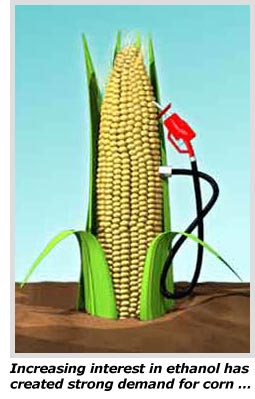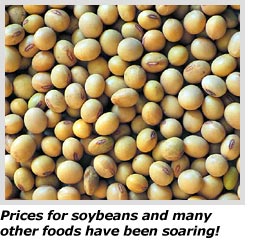Investing in Groceries
Commodities / Agricultural Commodities Jul 25, 2007 - 08:36 AM GMTSean Brodrick writes: You've probably heard plenty of talk about how rising demand for ethanol is driving up the price of corn. But that's just the tip of the iceberg lettuce.
Food prices of all types are rising at a fast clip around the world. In fact, they're up an average of 23% in the past 18 months, according to data from the International Monetary Fund.
I believe this trend is going to continue. And while it may pinch your wallet, it also presents the potential for a bumper crop of profits. Let me explain …
Lots of Corn, But Not a Lot of Anything Else
In the U.S., a bill is working its way through Congress that calls for 36 billion gallons of ethanol production by 2012. As a result, annual corn-based ethanol output in the U.S. is expected to double between 2006 and 2016. And over the same time period, China's ethanol output is expected to rise 111%!
Farmers have planted tons of corn in anticipation. For 2007, the area of planted corn in the U.S. is estimated at 92.9 million acres, up 19% from 2006 and 14% higher than 2005. That's the highest planted area since 1944!

Right now, there's actually a surplus, and that's led to a temporary dip in prices. Still, corn is up 30% from a year earlier, and has nearly doubled in the past two years.
Meanwhile, if farmers are planting too much corn, they're not planting enough of other crops. Take soybeans, for example. The 2007 U.S. soybean planted area is estimated at 64.1 million acres, down 15% from last year.
End result: Higher prices. And this kind of dynamic is happening throughout the food chain!
Here are some facts …
- In just the month of June, U.S. food prices were up 0.5%, after rising 0.3% in May.
- Economists expected food prices to rise 4% this year, and we had already hit that by May.
- Prices of fresh fruits and vegetables have risen 6.7% so far this year.
- In fact, the last time the price of groceries went up more than 4% was 1990, when they rose 6.5%.
However, things could get a lot worse. U.S. food prices jumped as much as 16.4% in 1973 and 14.9% in 1974. The driving factor in those years was higher gasoline prices … much as we're seeing now!

You may not even realize how fast food prices are rising, thanks to sleight-of-hand by food manufacturers. For example, at the end of June, General Mills introduced smaller boxes for Cheerios, Chex and Wheaties. While the prices were slightly lower, the price-per-ounce went higher!
Here Are Some Foods You Might Want to Keep an Eye On …
I think each of these is on the launch pad, with prices ready to move higher …
Wheat: Farmers will harvest 1.562 million bushels of winter wheat this year, 3.3% less than estimated in May, according to the U.S. Department of Agriculture. Prices for wheat have already surged 54% in the past 12 months as global demand outpaces supply for the seventh time in eight years.
Globally, the wheat crop is expected to fall 6.1%, making 2007 the smallest wheat crop since 1982. Australia's western wheat belt is suffering a terrible drought, and a heat wave is baking Canadian wheat. And in Europe, wheat farmers are being flooded out.
Pork and Beef: Pigs and cows eat corn and other grains. Because prices for feed are rising, so are beef and pork prices.
As a Chicago trader told me this week, it used to be that live cattle prices would fall when grain prices went up. Reason: Ranchers wouldn't want to feed their cattle so they'd dump them on the market.
But that's no longer the case — farmers are just taking the risk and passing the costs along to consumers. So far demand hasn't slacked off.
Milk: The drought in Australia is drying up dairy exports to the Pacific Rim. This is causing a chain reaction of dairy demand around the world. Add in higher fuel prices that dairy farmers in the U.S. are paying, and the price of milk moo-ooves to more than $4 per gallon. Heck, in some parts of the U.S., the per-gallon price of milk is up 55% in just the past year!
Ice cream: Is nothing sacred? Because I'm telling you, if my wife doesn't get her ice cream, I am going to be in a world of hurt!
Unfortunately, as the price of milk goes higher, so does the price of ice cream. That's because the price of butterfat — used in ice cream — is soaring, too.
By the way, other agricultural products are in a supply/demand squeeze, too. For example, the amount of cotton planted in 2007 in the U.S. is estimated at 11.1 million acres, down 28% from last year. Meanwhile, Chinese demand for cotton is rising at a rapid clip.
How to Profit from Surging Grocery Bills
There are plenty of ways to make a profit on rising food prices. Here are just two ideas (and one investment to avoid) …
First, if you like individual stocks, check out Archer-Daniels-Midland (ADM) . This "supermarket to the world" processes, sells, and ships many types of agricultural products. It is one of the world's largest processors of oilseeds, corn, and wheat. And although ethanol is a small part of its overall business, ADM is the largest domestic play in the industry.
Second, if you prefer investing in funds, take a look at Fidelity Select Food and Agriculture (FDFAX) . It invests at least 80% of assets in securities of companies principally engaged in the manufacture, sale, or distribution of food and beverage products, agricultural products, and products related to the development of new food technologies.
The fund has an expense ratio of 0.98%, and has returned 22.6% in the past year. Its holdings range from SYSCO (a food wholesaler) to major food companies like General Mills.
Third, here's one investment you might want to avoid: Powershares Agricultural ETF (DBA) . Launched in January, this exchange-traded fund invests in contracts for sugar, soybeans, corn, and wheat, with each commodity comprising 25% of the index.
It sounds good in theory. But the fund hasn't really tracked the increase in spot prices. Why? Since the market expects the price of these different agricultural products to go up, that's already reflected in the futures contracts that the DBA buys.
Yours for trading profits,
By Sean Brodrick
This investment news is brought to you by Money and Markets . Money and Markets is a free daily investment newsletter from Martin D. Weiss and Weiss Research analysts offering the latest investing news and financial insights for the stock market, including tips and advice on investing in gold, energy and oil. Dr. Weiss is a leader in the fields of investing, interest rates, financial safety and economic forecasting. To view archives or subscribe, visit http://www.moneyandmarkets.com .
Money and Markets Archive |
© 2005-2022 http://www.MarketOracle.co.uk - The Market Oracle is a FREE Daily Financial Markets Analysis & Forecasting online publication.



